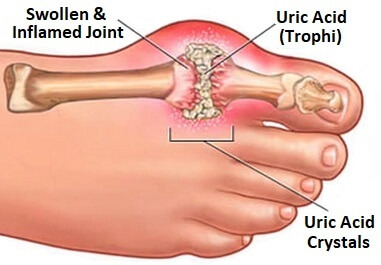 Gout is a common form of arthritis that can cause sudden and severe pain in the joints. It is characterized by the accumulation of urate crystals in the joints, leading to inflammation and discomfort. In this comprehensive guide, we will delve into the causes, symptoms, and treatment options for gout, providing you with a thorough understanding of this condition.
Gout is a common form of arthritis that can cause sudden and severe pain in the joints. It is characterized by the accumulation of urate crystals in the joints, leading to inflammation and discomfort. In this comprehensive guide, we will delve into the causes, symptoms, and treatment options for gout, providing you with a thorough understanding of this condition.
What Causes Gout?
Gout occurs when there are high levels of uric acid in the blood. Uric acid is a byproduct of the breakdown of purines, which are natural chemicals found in the body and certain foods. When the body produces excessive uric acid or fails to excrete it efficiently, urate crystals can form and accumulate in the joints, triggering gout attacks.
Several factors can contribute to the development of gout:
Diet
Eating foods that are high in purines can increase the risk of gout. Red meat, organ meats (such as liver and kidneys), certain types of seafood (including anchovies, sardines, and mussels), and sugary sodas are examples of purine-rich foods. Consuming these foods in excess can lead to elevated uric acid levels in the body.
Lifestyle Choices
Certain lifestyle choices can contribute to the development of gout. Excessive alcohol consumption, particularly beer, can raise uric acid levels and increase the likelihood of gout. Additionally, consuming beverages sweetened with high-fructose corn syrup can also elevate uric acid levels.
Weight
Being overweight or obese can make you more susceptible to gout. Excess weight can lead to higher uric acid production and impair the kidneys’ ability to eliminate uric acid effectively.
Medical Conditions
Several medical conditions are associated with an increased risk of gout. These include untreated high blood pressure, diabetes, obesity, metabolic syndrome, and heart and kidney diseases. Individuals with these conditions may have difficulty regulating uric acid levels, leading to gout.
Medications
Certain medications can contribute to the development of gout. Low-dose aspirin, thiazide diuretics, angiotensin-converting enzyme (ACE) inhibitors, beta blockers, and anti-rejection drugs used after organ transplantation can all increase uric acid levels.
Family History
Having a family history of gout can make you more susceptible to the condition. If one or more members of your family have had gout, your risk of developing it is higher.
Age and Sex
Gout is more common in men than in women, primarily due to hormonal differences. Men typically experience their first gout attack between the ages of 30 and 50, while women may develop symptoms after menopause when their uric acid levels increase.

Symptoms of Gout
Gout often presents with sudden and intense joint pain, typically affecting the big toe. However, it can also affect other joints such as the ankles, knees, elbows, wrists, and fingers. The following symptoms are commonly associated with gout:
Intense Joint Pain
Gout attacks are characterized by excruciating pain in the affected joint. The pain is often most severe within the first four to 12 hours after the onset of symptoms. While the big toe is the most commonly affected joint, any joint can be involved.
Swelling and Inflammation
The joint affected by gout becomes swollen, tender to the touch, and visibly inflamed. The skin around the joint may appear red and feel warm to the touch.
Limited Range of Motion
As gout progresses, it can cause limited mobility in the affected joint. Moving the joint may become difficult and painful.
Lingering Discomfort
After the initial intense pain subsides, some joint discomfort may persist for a few days to a few weeks. Subsequent gout attacks tend to last longer and may affect multiple joints.
It is important to note that gout symptoms can vary from person to person, and some individuals may experience mild symptoms or no symptoms at all between attacks.
When to Seek Medical Attention
If you experience sudden and severe joint pain, it is essential to consult a doctor. Untreated gout can lead to worsening pain and joint damage. Seek immediate medical care if you have a fever along with hot and inflamed joints, as this may indicate an infection.
Diagnosing Gout
To diagnose gout, your doctor will evaluate your medical history, conduct a physical examination, and order specific tests. These steps are essential to rule out other causes of joint pain and confirm a gout diagnosis. Some common diagnostic methods include:
Joint Fluid Analysis
Joint fluid analysis is the most effective method for diagnosing gout. Your doctor will extract fluid from the affected joint and examine it under a microscope for the presence of urate crystals.
Blood Test
A blood test can measure the levels of uric acid in your blood. However, it is important to note that some individuals with high uric acid levels may not experience gout symptoms, while others with gout may have normal uric acid levels. Therefore, blood tests alone are not sufficient for a definitive diagnosis.
Imaging Tests
Imaging tests such as X-rays, ultrasound, magnetic resonance imaging (MRI), and dual-energy computerized tomography (CT) scans can help visualize uric acid crystals in the joints. These tests are especially helpful in determining the extent of joint damage caused by gout.
Managing Gout: Treatment Options
The treatment plan for gout aims to alleviate symptoms, prevent future gout attacks, and reduce the risk of complications. The specific approach will depend on the frequency and severity of your symptoms, as well as any underlying medical conditions. Treatment options include:
Lifestyle Changes
Adopting certain lifestyle modifications can help manage gout and reduce the frequency of attacks. These changes may include:
-
- Maintaining a healthy weight: Losing excess weight can lower uric acid levels and reduce the risk of gout.
- Following a balanced diet: Limiting foods high in purines, such as red meat and organ meats, can help decrease uric acid production. Incorporating more fruits, vegetables, whole grains, and low-fat dairy products into your diet is beneficial.
- Staying hydrated: Drinking an adequate amount of water can help flush out uric acid from the body.
- Limiting alcohol consumption: Alcohol, particularly beer, can increase uric acid levels and trigger gout attacks.
- Avoiding sugary beverages: Drinks sweetened with high-fructose corn syrup can contribute to elevated uric acid levels.
Medications
Medications may be prescribed to manage gout symptoms and prevent future attacks. These include:
-
- Nonsteroidal anti-inflammatory drugs (NSAIDs): NSAIDs such as ibuprofen and naproxen can help relieve pain and reduce inflammation during gout attacks.
- Colchicine: This medication is specifically used to treat gout and can be effective in reducing pain and inflammation. It is often used in lower doses to minimize side effects.
- Corticosteroids: In severe cases or when NSAIDs and colchicine are not suitable, corticosteroids may be prescribed to alleviate inflammation and pain.
- Uric acid-lowering drugs: If you experience frequent gout attacks or have complications such as tophi or joint damage, your doctor may prescribe medications to lower uric acid levels. Allopurinol is commonly prescribed as a first-line treatment, while febuxostat may be considered for those who cannot take allopurinol.
It is important to follow your doctor’s instructions and take medications as prescribed to effectively manage gout.
Self-Care Measures
In addition to medication and lifestyle changes, certain self-care measures can help alleviate gout symptoms and promote overall joint health. These include:
-
- Applying ice packs: Applying ice packs to the affected joint can help reduce pain and swelling during a gout attack.
- Resting the joint: Allowing the affected joint to rest and avoiding excessive movement can help minimize discomfort.
- Elevating the joint: Elevating the affected joint can help reduce swelling and promote healing.
- Protecting the joint: Wearing supportive footwear and using assistive devices like crutches or canes can help alleviate pressure on the affected joint and prevent further damage.
Complications of Gout
If left untreated or poorly managed, gout can lead to several complications:
Recurrent Gout
Some individuals may experience recurrent gout attacks, with symptoms recurring several times a year. These attacks may become more severe over time and involve multiple joints. Medications can help prevent or reduce the frequency of gout attacks in these cases.
Advanced Gout
Untreated gout can lead to the formation of tophi, which are large masses of uric acid crystals that accumulate in soft tissues or bones around the joints. Tophi can cause swelling and tenderness, particularly during gout attacks. In severe cases, tophi may require surgical intervention for removal.
Kidney Stones
Urate crystals can also accumulate in the urinary tract, leading to the formation of kidney stones. These stones can cause severe pain and discomfort and may require medical intervention or surgical procedures to remove them.
Managing Gout Holistically
In addition to medical interventions, it is essential to consider the holistic management of gout. This includes taking care of your mental and emotional well-being, as gout can be associated with stigma and impact your overall quality of life.
Addressing Stigma and Mental Health
Gout has been historically associated with excess and is often the subject of jokes and stereotypes. This stigma, along with the fear of experiencing another painful gout attack, can contribute to stress and inflammation in the body. It is important to talk openly about gout and seek support from friends, family, and healthcare professionals. Engaging in regular exercise, getting adequate restorative sleep, and consuming a healthy diet can also contribute to improved mood and overall well-being.
Gout is a complex form of arthritis that can cause significant pain and discomfort. However, with appropriate lifestyle changes, medication, and self-care measures, it is possible to manage gout effectively. By understanding the causes, recognizing the symptoms, and following the recommended treatment options, individuals with gout can lead a fulfilling and pain-free life. If you suspect you may have gout or are experiencing joint pain, it is crucial to consult a healthcare professional for an accurate diagnosis and personalized treatment plan.
Contact Us (859-331-3100) For More Information or to Request an Appointment
—
 About Tristate Arthritis and Rheumatology
About Tristate Arthritis and Rheumatology
Tristate Arthritis and Rheumatology is the first and largest Rheumatology practice in the Northern Kentucky area. Founded by Dr. Arthur Kunath in 1986, our rheumatology practice now consists of six doctors who are board certified in both Internal Medicine and Rheumatology and a Physician Assistant. Patients see one doctor (except in emergencies), thereby assuring continuity of care and an individualized docteor-patient atmosphere giving the physician the ability to establish personalized and detailed relationships. Our doctors have received numerous awards, including being listed as “Top Doctors” in Cincinnati Magazine, receiving the Patient’s Choice Award, the Most Compassionate Doctor Award, and the American College of Rheumatology’s “My Doc Rocks” award.


